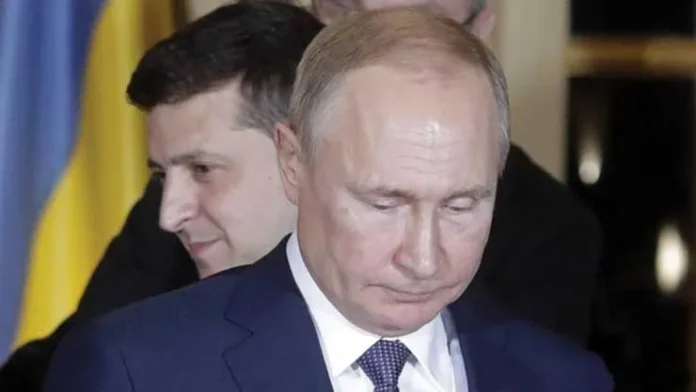President Vladimir Putin by ordering Russian armed forces to launch special military operations to ‘demilitarise’ and for ‘de-nazification’ of Ukraine after almost a three-month-long process to amass at least 140 thousand highly capable troops, has overnight changed the security calculus not only in Europe, but also de facto by ending the unipolar world order.
Ignoring the US-led NATO alliance’s warnings of ‘crippling’, ‘out of hell’ sanctions, thousands of combat ready troops—many of whom have seen action in Syria—entered Ukraine from three directions. This was after receiving Washington’s “No” to Moscow’s demand to stop the eastward expansion of the western alliance or to give written guarantees to not admit former Soviet republics of Ukraine and Georgia (homeland of former Soviet dictator Josef Stalin).
This led to imposition of a wide range of sanctions against major Russian banks, a number of Kremlin officials and entities including many defence suppliers. Local experts say some of them were already under various US and EU sanctions for the Russian annexation of Crimea in 2014 and the West’s various sanctions. According to British Prime Minister Boris Johnson, the new sanctions are aimed to destroy the Russian economy. But the matter of concern for India is that these sanctions create geopolitical risks for Russia’s defence cooperation with India. With the Damocles’ sword of US CAATSA sanctions hanging over India over the purchase of the S-400 anti-missile system from Russia, the chances of seeking a waiver from Washington in the current scenario looks very problematic.
New Delhi is already under intense pressure to sever cooperation with Moscow, which is not following rules set by the West—Quod licet Jovi, non licet bovi (what is permissible for Jupiter may not be permissible for a bull). So far Prime Minister Narendra Modi’s government is pursuing a very fine balance on the Russia-NATO standoff over Ukraine. Frankly speaking, India has friendly relations with all the parties involved in the geostrategic chutzpah and is hence retaining its own strategic autonomy. Many analysts here see this as President Putin’s response to the greater American plan to formalise US-China “G-2” by making Russia a junior partner. Putin got this impression after the Geneva summit with President Biden last year. The Russian President with ambitions of restoring Russia’s imperial glory is not inclined to be anybody’s junior partner. In a tit-for-tat, he is playing the China card against the US who played it for destroying its military-ideological foe Soviet Union.
Russia sees India as a pole in a multi-polar world order and in this context it is noteworthy that Putin flew to New Delhi just for a six-hour visit for a summit with Prime Minister Modi by travelling more than 12 hours to-and-fro journey from Russia—his first bilateral foreign visit since the pandemic, not counting the Geneva summit with President Biden. Putin’s New Delhi summit was preceded by the maiden India-Russia 2+2 meeting of defence and foreign ministers, so that they could report to their principals for taking final decisions on sensitive and sticky security and defence issues.

Agreement on Programme of Military-Technical Cooperation from 2021-2031 was one of the key documents signed during President Putin’s blitz visit. This 10-year defence cooperation programme outlines the ongoing defence cooperation and defines future cooperation between the two countries. India—the first and perhaps the only country with which post-Soviet Russia signed the Indo-Russian Long Term Programme for Military-Technical Cooperation (ILTP-MTC) in 1994—synchronises Indian armed forces’ development programme with the Russian defence industry’s R&D for India-specific weapon systems and platforms.
BrahMos cruise missiles, Sukhoi Su-30, Talwar class frigates, T-90 main battle tanks and Arihant nuclear-powered submarines and Vikrant aircraft carrier are some of the projects in public domain which were materialised due to ILTP-MTC.
According to a former ambassador to Moscow, the defence cooperation with Russia which is in public domain is the tip of the iceberg and transforming from a buyer-seller relationship to a joint R&D effort.
However, all this is at stake due to western sanctions across the board and it depends on how the leadership views the global implications of continuing ties with Russia. For India, this is a challenging moment similar to the Soviet invasion of Afghanistan. But this is a moment of global geostrategic turmoil fraught with perils and opportunities for emerging as an influential power in the new world order.

The policy of “Atmamirbhar Bharat” was adopted timely and has scared arms exporters, but Russia seems to be keen to go ahead with the transfer of technologies and would be more willing in the new scenario after the Ukraine action.
A former diplomat had told me several years back that Indo-Russian trade and defence cooperation robustly developed whenever Russia was under western sanctions and curbs. It is time now to urgently go back to the Rupee-Rouble system for bilateral trade and defence, albeit in a new avatar. According to earlier reports, the RBI and Bank of Russia have been testing direct transactions through the Russian system of electronic funds transfer. There have been talks about mutual acceptance of India’s Rupay and Russia’s rouble denominated Mir cards without going through dollar conversion.

Past experience shows that the rival superpowers ultimately come to some understanding but smaller and middle powers fall victim to the policy of taking sides. India is a great power in its right and should independently chalk its strategic course because in the present scenario, only China seems to be emerging stronger and a weak Russia, which has inherent differences with China, is not in India’s interest when there is always a possibility of Washington and Beijing joining hands due to vast economic interests.
– The writer is a Moscow-based independent analyst. Views are personal.
–The writer is a Moscow-based independent defence analyst. The views expressed are personal and do not necessarily reflect the
views of Raksha Anirveda






